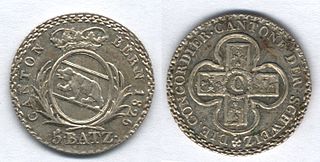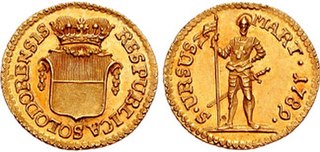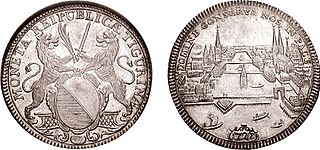
The Swiss franc is the currency and legal tender of Switzerland and Liechtenstein. It is also legal tender in the Italian exclave of Campione d'Italia which is surrounded by Swiss territory. The Swiss National Bank (SNB) issues banknotes and the federal mint Swissmint issues coins.

The Frank was the currency of the Swiss canton of Aargau between 1798 and 1850. It was subdivided into 10 Batzen, each of 4 Kreuzer or 10 Rappen. It was worth 1⁄4th the French silver écu or 6.67 g fine silver.
The Basel frank was the currency of the Swiss canton of Basel between 1798 and 1850. It was worth 1⁄4th the French silver écu or 6.67 g fine silver.

The Berne Thaler was a coin equivalent to the French silver écu issued by the Swiss canton of Bern. It contained 26.67 g fine silver and was valued at 4 livres.

The Frank was the currency of the Swiss canton of Berne between 1798 and 1850. It was subdivided into 10 Batzen, each of 10 Rappen. It was worth 1⁄4th the French silver écu or 6.67 g fine silver.
The Fribourg Gulden was a currency denomination worth 14 Batzen of the Swiss canton of Fribourg until 1798.
The Frank was the currency of the Swiss canton of Fribourg between 1798 and 1850. It was subdivided into 10 Batzen, each of 4 Kreuzer or 10 Rappen. It was worth 1⁄4th the French silver écu or 6.67 g fine silver.
The Frank was the currency of the Swiss canton of Graubünden between 1798 and 1850. It was subdivided into 10 Batzen, each of 6 Bluzger. It was worth 1⁄4th the French silver écu or 6.67 g fine silver.

The Frank was the currency of the Swiss canton of Luzern between 1798 and 1850. It was subdivided into 10 Batzen, each of 10 Rappen or 20 Angster. It was worth 1⁄4th the French silver écu or 6.67 g fine silver.
The gulden was the currency of the Swiss canton of Luzern until 1798. It was subdivided into 40 schilling, each of 3 rappen or 6 angster. Coins were also issued denominated in kreuzer and batzen. The French silver écu was equivalent to 3 gulden.
The gulden a currency denomination of Neuchâtel equal to 21 batz until 1850. Neuchâtel's basic currency unit was the livre, divided into 10 batz or 40 kreuzer. The French silver écu was worth 42 batz or 2 gulden. It was replaced by the Swiss franc.
The Thaler was a currency denomination worth 2 Gulden used by St. Gallen until 1798.
The Frank was the currency of the Swiss canton of St. Gallen between 1798 and 1850. It was subdivided into 10 Batzen, each of 4 Kreuzer or 16 Pfennig. It was worth 1⁄4th the French silver écu or 6.67 g fine silver.
The Frank was the currency of the Swiss canton of Schaffhausen between 1798 and 1850. It was subdivided into 10 Batzen, each of 4 Kreuzer. It was worth 1⁄4th the French silver écu or 6.67 g fine silver.

The Solothurn Thaler was a coin equivalent to the French silver écu issued by the Swiss canton of Solothurn until 1798. It contained 26.67 g fine silver and was valued at 4 livres.
The Frank was the currency of the Swiss canton of Solothurn between 1798 and 1850. It was subdivided into 10 Batzen, each of 4 Kreuzer or 10 Rappen. It was worth 1⁄4th the French silver écu or 6.67 g fine silver.
The Frank was the currency of the Swiss canton of Thurgau between 1798 and 1803. It was subdivided into 10 Batzen, each of 4 Kreuzer. It was worth 1⁄4th the French silver écu or 6.67 g fine silver.
The Frank was the currency of the Swiss canton of Unterwalden between 1798 and 1850. It was subdivided into 10 Batzen. It was worth 1⁄4th the French silver écu or 6.67 g fine silver.
The Valais thaler was a coin equivalent to the French silver écu issued by the Swiss canton of Valais until 1798. It contained 26.67 g fine silver and was valued at 4 livres.

The cantons of the Old Swiss Confederacy used a currency system consisting of based on the old unit of the Schilling, with the Schilling divided into 4 Rappen or 12 Haller. The Taler was a large silver coin equivalent to 72 Schilling or 2 Gulden that came into use in the 16th century. The Batzen was an intermediate coin equivalent to 2 Schilling or 1⁄18Gulden.








